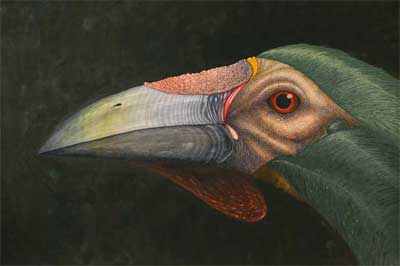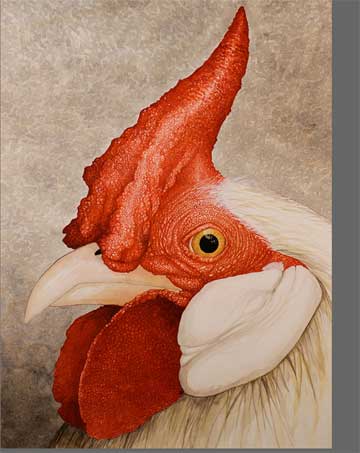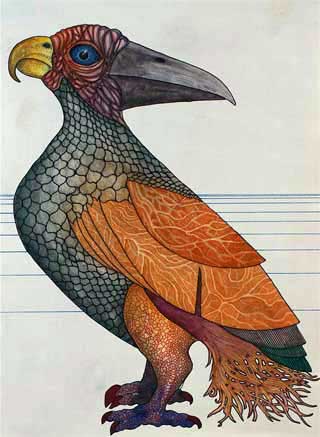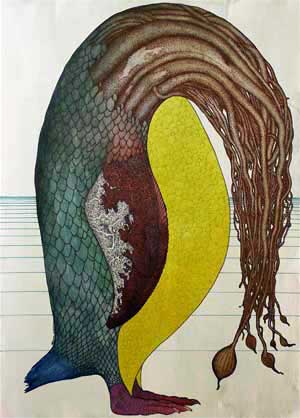
Watercolor on paper, 30″ x 20″
Image courtesy of the artist
I had the occasion to see some of Sean Dunstan-Halliday’s work on the web a few months back and was immediately struck by the vividness of his images. Today I got a chance to see them first-hand and got an even more electric sense of what they had to offer.
Working largely in pen and watercolor on paper, Dunstan-Halliday creates striking images of birds, and of fantastical combinations of birds, reptiles and vegetation.

Watercolor on paper, 18″ x 24″
Image courtesy of the artist
His images of chickens, roosters and of various kinds of toucans and tropical bird confabulations are texturally fascinating and magnetic in their appeal. Who knew that the eye of a rooster could be so – well – human? The coats, feathers, scales and adornments of these creatures are variegated worlds and sweep the eye with fascination, while the driving core of those eyes is penetrating and seductive. These works really drew me in – as graphically stunning, and as compelling studies in personality, or whatever it is that one might call that kind of bird-soul.

Watercolor and pen on paper, 11″ x 14″
Image courtesy of the artist
Other works are clearly experimental ventures, probing the realm of morphing and mutation. Bird bodies take on multiple heads (fascinating!) and grow extensions that look like large sheets of algae (interesting, but less dramatic).
This set of explorations is not only engaging in its own right, but Dunstan-Halliday is working, in the artistic realm, with a palette of ideas that echo what is currently pressing against the imaginative borders of genetic studies.
While exploring all the morphological fusings and graftings that those genetic studies suggest, this artistic exploration, in its most vivid moments, raises the inevitable question about what lies within.
What will the eyes of those imaginative beings continue to say to us? Though their bodies might be arcane aggregates, will their eyes continue to reveal something to which we can relate? As bodies become crafted and grafted, what will become of the forms of awareness that go along with them?

Watercolor and pen on paper, 14″ x 20″
Image courtesy of the artist
In an evolving language strange and beautiful forms, Dunstan-Halliday’s constructions weave wonderful fables, which come back to asking important questions about the nature of the being that bears those forms and the self which pervades it.
And, with painstaking attention to the rendering of these potent and sometimes bizarre images, Dunstan-Halliday erases the boundaries within which creatures achieve their most normal identities in search of something more jazz-like and complex. He asks us, as it were, to catch his zoological beat and take off into a fantastical rhythmic space in which the old shoulders begin to shake, and in shaking, begin to form new wings, and fly.
– BADMan
Leave a Reply